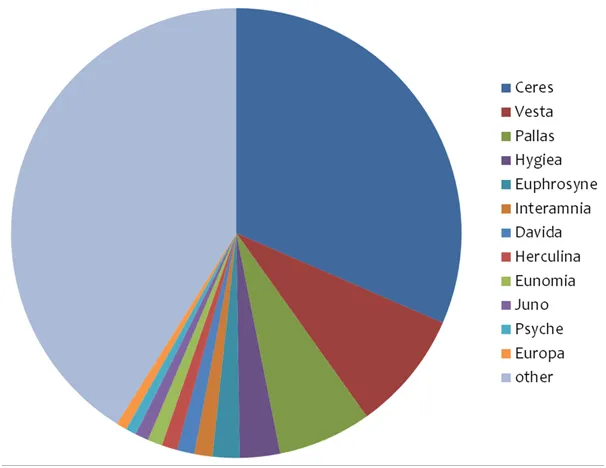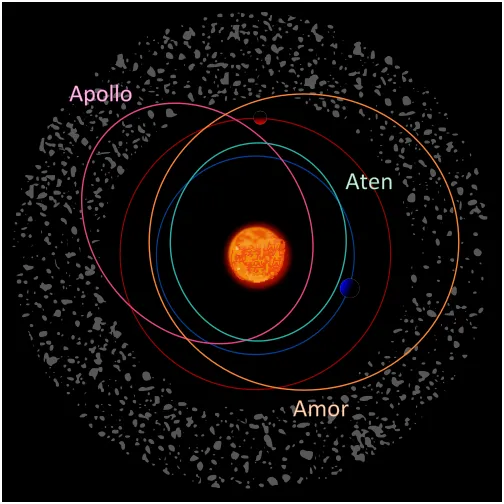The millions of asteroids in our solar system that have formed planets from their debris some 4.6 billion years ago also move around the sun, so not only the 8 planets we know are moving around the sun.

There is an area in the solar system that contains small stones of various sizes available, the area is called Main Belt of Asteroids. Here is available a variety of sizes from the size of 1000 km to the rock size of a dust grain. Asteroid stones are also found around the sun from the Earth's inner orbit until they are found on the outside of the planet's orbit Jupiter, so not only in the Main Belt of Asteroids we know.
In the Asteroid Main belt, the smallest rock is named 10 Hygiea and the largest 1 Ceres next 4 Vesta and many others. You see the Moon if all the Asteroid rocks found in the Asteroid Main Belt are collected then the magnitude is only 4% mass of the Moon size.

The relative masses of the twelve largest asteroids known.wikipedia
1801 is the year of discovery of the first asteroid that Ceres discovered by Piazzi, then the asteroid is classified as a planet by astronomers. In vision by Piazzi ceres the asteroid looks rather unlike the round disk like the planet in general. It's the same as Vesta, Pallas, and Juno. Because of the smaller size of a planet we know that the planets are round and the asteroid rocks have irregular shapes, that's the conclusion of the observers.
Another question arises. Are these little objects found between Mars and Jupiter these are the ruins of a ruined planet? If it is a devastated planet, how big are these things? These questions arose in the 18th century when the new telescope was nearly 200 years old.
Then a question, a long-standing question. The question has emerged since 200 years after the discovery of the telescope around the 18th century. So when the discovery of debris around the planet Jupiter and Mars, whether the debris is a planet that has been destroyed? The scientists need an answer to the question. The question remains a mystery as to whether the planet has been destroyed?
Asteroids Derived from Planetesimals
Small objects in the Solar System that we know as asteroids are thought to be formed from planetesimal, just like the planets of the earth. But, these planetesimals never made it into a planet. The rest of the debris that failed to join the planet is what we know as an asteroid. In the main asteroid belt, Jupiter's gravity is so strong that it causes the failure of the planetary formation between Mars and Jupiter.

Collisions that occurred in the past and now, slowly breaking the rocks of the asteroids become smaller. The remaining dust grains are also eventually destroyed by radiation. Although the vast majority of the remains of planetary formation are irregularly sized, Ceres, the largest asteroid in the Asteroid Belt, is large enough to have gravity large enough to maintain a round shape. However, since 2006, Ceres's status is no longer an asteroid but a dwarf planet. And since then, the largest asteroid in the Main Belt is Vesta.
The remaining debris of planetary formation can be found also in freezing conditions outside the orbit of Neptune. It's just that his name is also different.
Asteroid Hunting
The new telescope was discovered in 1608 and was used by Galileo for the observation of celestial bodies in 1609. Though the 200 years passed, its development is of course not what it is today. Even the problem of chromatic aberration on a new telescope was solved 71 years earlier by Chester Moore Hall. Newton also made a reflector telescope in 1668 to address the problem of chromatic aberration.

In 1894, US astronomer E. E. Barnard calculated to obtain the size of the discovered asteroids such as Ceres, Juno, Pallas, and Vesta, with an Lck 91 cm refractor telescope at Mt. Hamilton, California. The result, Vesta is initially the largest estimate is just 439 km while Ceres is even larger that is 964 km. Pallas is known to measure 381 km.
But, it is not easy to know the size of these small objects directly. One of the important information needed to know the size of the asteroid is the absolute magnitude and albedo. The absolute magnitude of the asteroid is the brightness of the small object when placed at a distance of 1 AU from Earth and 1 AU from the Sun. While albedo is the ability of objects in reflecting light.
For asteroids with 100% albedo, it means that the small object is very bright because it reflects the entire light received. If albedo is 0%, there is no reflected light, and the detected object is very dark. Most of the primitive asteroids are very dark because they reflect only a small amount of light received. Asteroid albedo can be known from the temperature of the object or it could be from the received spectrum.
Asteroids from Composition
We can know the information of the celestial bodies from the received light spectrum. Can be from light emitted or also reflected the celestial body. This information is accepted by observers of asteroids. Although dim, the received spectrum can tell you about the composition of the asteroid.
Most of the earth or meteorite rocks are known to contain silicate minerals such as feldspar, olivine, peroxin, and phyllosilicates that resemble different types of clays.
In 1975, Clark R. Chapman, David Morrison, and Ben Zellner divided the asteroids based on compositions in 3 categories, the C-type, the S-type and the U-type. The division is done after they see the pattern of the 110 asteroid spectrum that has been calculated diameter and albedo. This classification continues to grow and to date, we recognize several categories of asteroids based on their composition.

Type-C is a grayish carbonaceous asteroid (carbon). This type of asteroid is dark because it has low albedo and has no specific features in the spectrum. Temperature is also low and only experienced low heating. Or even never experienced warming up. This C-type asteroid is the most common and is thought to have a composition of clay and silicate rocks. In the main asteroid belt, the C-type occupies the outermost region of the belt.
The second most common type of asteroid is the S-type or Stony asteroid (rock). Asteroid silicate is bright enough reddish green with moderate albedo. The S-type has 17% of the population of all asteroids and dominates the area within the Main Belt. Its main composition, silicate material, and nickel-iron.
Type-M, metallic asteroids or metal asteroids and appear reddish and quite dark because it has moderate albedo. This type of asteroid spectrum is similar to the iron meteorite and enstatite chondrites, a meteorite composed by iron-nickel grains in the entity, a silicate-rich in magnesium. This type of asteroid can be found in the middle area of the Main Belt.
The other type is the E-type, an asteroid with a very high albedo and looks very bright. In addition, there are asteroids type D and type P which amounts to about 5 - 10% of all the asteroids. These D and P types are asteroids that are darker and redder than S-type asteroids and much more primitive than C-type carbonaceous asteroids. Both are suspected to contain organic compounds formed due to space weather.
Interesting compositions can also be found on V-type asteroids that have a high albedo and shrouded in volcanic kernel from basalt material. An example is an asteroid Vesta. The other type is a W-type asteroid that has hydration.
Asteroid from its Orbit

Asteroid Belt and Trojan is the location of the existence of asteroids in the Main Belt and Lagrangian point Jupiter.wikimedia
In the Solar System, asteroids occupy an area between Mars and Jupiter that we know as the Main Belt of Asteroids. In this area, there are 1.1 to 1.9 million asteroids larger than 1 km and there are still millions of much smaller asteroids.
Outside of the main asteroid belt, we can find similar small objects sharing orbits with large planets like Jupiter, Neptune, Mars, and Earth, but not colliding with the planets. The asteroid known as a trojan is located in two special locations known as the Lagrangian point. In this area, the gravity of the Sun and Jupiter create stability.
There are also asteroids wandering around the sun from near the Earth. Near Earth asteroids less than 1.3 AU. These objects surround the sun with orbits that cut Earth's orbit. Until 2017, more than 16294 recorded asteroids near Earth have been discovered and 1786 of them are potentially harmful to Earth.

Asteroids near the Earth also have different groups based on their orbits. The first is the Amor asteroid located near Earth's orbit between Earth and Mars. But, asteroids in this class never cut Earth's orbit. The next group is Apollo which cuts Earth's orbit and has a larger semi-axis larger than Earth. Apollo asteroids spend most of their time off the Earth. In addition to Apollo, another group that cuts Earth's orbit is the Aten asteroid. The difference is, these asteroids have a semi-major axis smaller than Earth so that the Aten asteroid more often in the Earth's orbit. The last one is the asteroid Atira whose orbit is in Earth's orbit.
Most of these asteroids are harmless. But the close exposure between the asteroids and the Earth remains under observation since a slight disturbance could alter the orbit of an asteroid that could endanger Earth.

BEST REGARDS @irza
Refence :
http://ircamera.as.arizona.edu/NatSci102/NatSci/lectures/debris.htm
https://www.space.com/6279-dead-stars-harbor-asteroids.html
http://www.scienceclarified.com/scitech/Comets-and-Asteroids/How-Asteroids-and-Comets-Formed.html
https://www.britannica.com/science/solar-system
https://www.space.com/37708-ancient-asteroid-family-solar-system-formation.html
https://www.space.com/16105-asteroid-belt.html
http://www.worldofphenomena.com/space/asteroid/
http://www.lunarplanner.com/asteroids-main/index.html
https://www.space.com/21950-who-invented-the-telescope.html
https://www.newscientist.com/article/2126301-backwards-asteroid-shares-an-orbit-with-jupiter-without-crashing/
http://astronomy.swin.edu.au/cosmos/N/Near+Earth+Asteroids